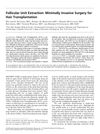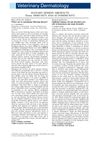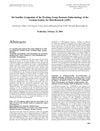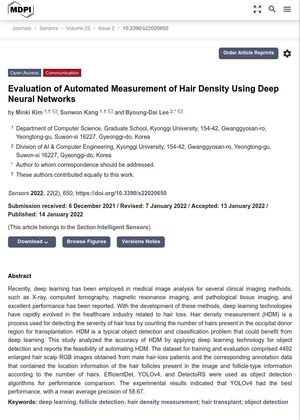TLDR Deep learning can accurately automate hair density measurement, with YOLOv4 performing best.
The study "Evaluation of Automated Measurement of Hair Density Using Deep Neural Networks" used deep learning models to automate Hair Density Measurement (HDM), a method for assessing hair loss severity. The models, EfficientDet, YOLOv4, and DetectoRS, were trained on 4492 hair scalp images from 817 male patients. YOLOv4 outperformed the other models with a mean average precision of 58.67 and showed the highest precision (80.75%), recall (80.22%), and accuracy (75.73%). However, all models struggled to detect Class 3 hair follicles, likely due to class imbalance and feature similarity with Classes 1 and 2. The study concluded that deep learning can provide accurate automated HDM with sufficient training data, suggesting potential for improved efficiency and accuracy in hair loss assessment.
 30 citations
,
April 2021 in “Journal of The American Academy of Dermatology”
30 citations
,
April 2021 in “Journal of The American Academy of Dermatology” Hair transplantation can effectively restore hair in balding areas.
74 citations
,
January 2020 in “IEEE Access” ScalpEye accurately diagnoses scalp issues like dandruff and hair loss.
 13 citations
,
August 2002 in “Dermatologic Surgery”
13 citations
,
August 2002 in “Dermatologic Surgery” FUE is a less invasive hair transplant method suitable for many patients, but it has limitations and may not replace traditional techniques.
 1 citations
,
March 2024 in “Skin research and technology”
1 citations
,
March 2024 in “Skin research and technology” A new AI model diagnoses hair and scalp disorders with 92% accuracy, better than previous models.
 October 2020 in “Veterinary Dermatology”
October 2020 in “Veterinary Dermatology” New treatments and diagnostic methods for various animal skin conditions showed promising results.
46 citations
,
July 2022 in “Frontiers in Oncology” Cold atmospheric plasma is a promising and safe treatment for various skin conditions.
 9 citations
,
January 2005 in “Experimental dermatology”
9 citations
,
January 2005 in “Experimental dermatology” Melatonin receptors in hair follicles help regulate hair growth and could treat hair loss.
 February 2025 in “International Journal of Cosmetic Science”
February 2025 in “International Journal of Cosmetic Science” Protein carbonylation is a sensitive marker for oxidative damage in hair, especially from light exposure.






